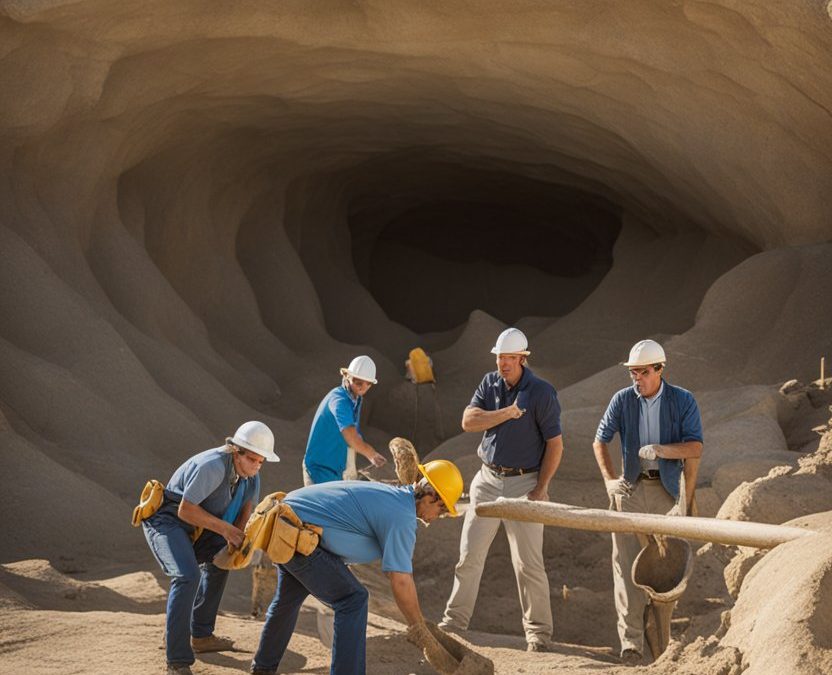Exploring Waco Mammoth National Monument is a fascinating journey into the lives of Columbian mammoths and other Ice Age animals. As the only nursery herd of Columbian mammoths in the U.S., the site is of great significance to paleontologists and history enthusiasts alike.
Upon arrival at the park, visitors are greeted by the beautiful wooded parkland that surrounds the monument. The park offers an escape from the modern world and provides an opportunity to immerse oneself in the natural environment that once housed these magnificent creatures. The site is also home to a Dig Shelter, where visitors can see the in-situ fossil remains of six Columbian mammoths and a few other Ice Age animals.
Explore Waco Mammoth Monument with guided tours, uncovering mammoth fossils and diverse ancient species. A must-see for history and nature enthusiasts
History and Discovery: Exploring Waco Mammoth National Monument
Explore the captivating history of Waco Mammoth National Monument, where in 1978, two local teens discovered the world’s largest concentration of Columbian mammoth fossils, shaping an extraordinary story.
Initial Discovery
Paul and Eddie’s discovery led to the involvement of Baylor University and the formation of the Waco Mammoth Foundation. The excavation of the site began in 1985, and over the next decade, the remains of 24 mammoths were unearthed. It was determined that these mammoths died during a single natural event, likely a flash flood. The discovery of these fossils shed new light on the behavior and social structure of these ancient creatures.
Excavation and Research
The excavation and research at the Waco Mammoth National Monument have been ongoing for over 30 years. The site is now managed by the National Park Service and is open to the public for tours and education. The fossils at the site are still being studied and analyzed, and new discoveries are being made all the time.
National Monument Designation
Designated a National Monument in 2015 by President Barack Obama, Waco Mammoth site fascinates visitors and researchers worldwide. The excavation yields insights into ancient creatures’ behavior, highlighting the significance of scientific research and preservation.
The Mammoths and Other Fossils: Exploring Waco Mammoth National Monument
As I explored the Waco Mammoth National Monument, I was fascinated by the diverse range of fossils that have been uncovered here. The park is home to a variety of Ice Age creatures, but the most impressive of all are the Columbian mammoths.
Columbian Mammoths
The Columbian mammoths are the centerpiece of the park. Thousands of years ago, these majestic creatures roamed across Texas, and researchers have discovered their remains in the bone bed at the Waco Mammoth National Monument. These mammoths stood as tall as 14 feet and weighed up to 20,000 pounds, making them one of the largest mammals to ever walk the earth.
Nursery Herd
One of the most exciting discoveries at the Waco Mammoth National Monument was the “nation’s first and only recorded evidence of a nursery herd of Pleistocene Columbian mammoths” (source: nps.gov).
A female mammoth and her offspring, found in close proximity, comprised this herd. The discovery of a nursery herd provides valuable insight into the social behavior of these magnificent creatures.
Other Ice Age Creatures
Explore diverse Ice Age fossils at Waco Mammoth National Monument, from Columbian mammoths to saber-toothed cats. A must-visit for paleontology enthusiasts, offering a captivating glimpse into our planet’s history.
Visitor Experience: Exploring Waco Mammoth National Monument
As someone who has visited the Waco Mammoth National Monument, I can say that it offers a unique and educational experience for visitors of all ages. Here are some things to keep in mind when planning your visit.
Tours and Programs
One of the best ways to experience the Waco Mammoth National Monument is by taking a guided tour. The tours are led by knowledgeable park rangers who will take you through the dig site and explain the history and significance of the fossils found there. The park offers tours several times a day, and they include them in the price of admission.
If you have children with you, be sure to check out the Junior Ranger program. The park designed this program to actively engage young visitors in its educational mission. Kids can pick up a Junior Ranger booklet at the visitor center and complete activities throughout their visit to earn a badge.
Amenities and Accessibility
The Waco Mammoth National Monument has a few amenities to make your visit more comfortable. There is a picnic area where you can enjoy a meal or snack, as well as restrooms and water fountains located throughout the park. The park also has a nature trail that is accessible to visitors with mobility impairments.
Explore the history and science of the park at Mayborn Museum Complex on Baylor University’s campus. Uncover Texas’ natural and cultural history through engaging exhibits.
For more information about the park and its educational attractions, visit the park’s website.
Conservation and Community: Exploring Waco Mammoth National Monument
Dedicated to preserving the remains of the Columbian mammoths that once roamed the area, Waco Mammoth National Monument stands as a testament to natural history. Ongoing preservation efforts are crucial to maintaining the integrity of the site and ensuring that future generations can learn about these magnificent creatures.
Ongoing Preservation Efforts
Preserving Waco Mammoth Monument involves strategic efforts, including meticulous excavation to protect fossils. The Dig Shelter is key for cleaning and analysis. A climate-controlled environment preserves the fossils, preventing deterioration.
Exploring Waco Mammoth National Monument involves not only preserving fossils but also maintaining the site against erosion and environmental hazards. The dedicated park staff educates visitors on the importance of conservation and respecting the natural environment
Volunteer and Educational Outreach: Exploring Waco Mammoth National Monument
Volunteers play a crucial role in the ongoing preservation efforts at the Waco Mammoth National Monument. Volunteers help with everything from excavating fossils to maintaining the park grounds. The park also offers educational programs for visitors of all ages, including guided tours, hands-on activities, and lectures by experts in the field.
The Waco community actively participates in preserving the Waco Mammoths. Local businesses support preservation, and the park collaborates with schools, providing educational opportunities for students.
In conclusion, Exploring Waco Mammoth National Monument provides a unique glimpse into the past.
By actively preserving and involving the community, the park ensures the enduring legacy of Columbian mammoths for future generations.

